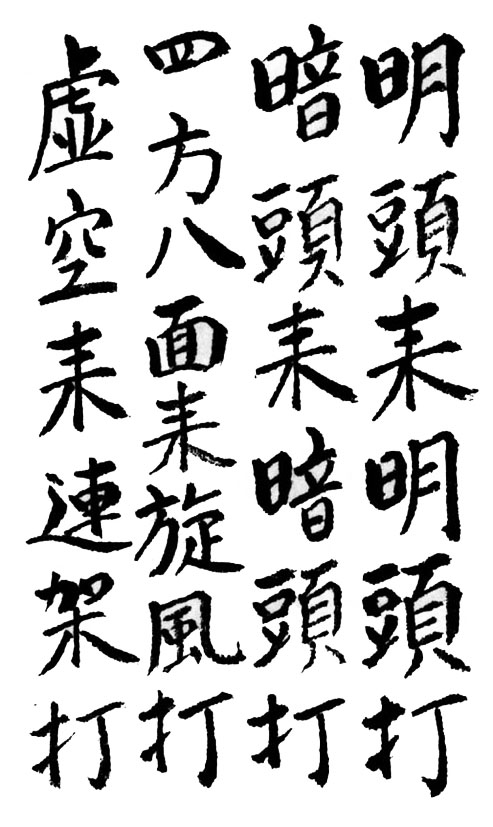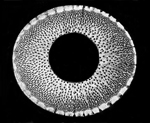|
680-850: Huineng, Shih-t'ou & P'u-k'o on 'Myōan sōzō
- The Complementary Pair "The Bright" & "The Dark"
Late 7th CENTURY - The PLATFORM SUTRA by HUI-NENG/ENŌ:

"The 6th Patriarch Cutting Bamboo"
by Liang-k'ai, late 12th to early 13th century:
四十六。
外境無情對有五對。
天與地對。
日與月對。
暗與明對。
陰與陽對。
水與火對。
- - -
暗不自暗、以明故暗。
以明顯暗、以暗現明。
來去相因。
- - -
"46.
"There are five pairs concerning external objects that are insentient, namely,
heaven and earth,
sun and moon,
light [myō/mei, 明]
and darkness [an, 暗],
passive element (yin) and positive element (yang),
water and fire."
- - -
"Darkness does not become darkness by itself;
it is dark because there is brightness.
Darkness is manifested by brightness, and brightness is revealed by darkness.
One is the cause of the other."
Quotations from Ch. 46 in the Platform Sutra, Chin.:
'Fa-pao-T'an Ching', by the 6th Ch'an patriarch Hui-neng,
638-713. Trsl. by Wing-tsit Chan, 1963, pp. 125 & 127.
8th CENTURY - The SANDŌKAI by SHIH-T'OU/SEKITŌ:
參同契 - SANDŌKAI
闇合上中言 明明清濁句
當明中有暗 勿以暗相遇
當暗中有明 勿以明相睹
明暗各相對 比如前後歩
" - - - Darkness is a word for merging upper and lower.
Light is an expression for distinguishing pure and defiled. - - - "
" - - - Right in light there is darkness,
but don't confront it as darkness.
Right in darkness there is light,
but don't see it as light.
Light and dark are relative to one another
like forward and backward steps. - - - "
Shih-t'ou Hsi-ch'ien (Jap.: Sekitō Kisen, 700-790) in the
Ts'an-t'ung-ch'i (Jap.: Sandōkai). Translation quoted from
the website www.berkeleyzencenter.org, entry: "Texts:
Liturgy &
basic texts: 'Merging of difference and unity/Sandokai'".
" - - - Refined and common speech come together in the dark,
clear and murky phrases are distinguished in the light. - - - "
" - - - In the light there is darkness,
but don't take it as darkness.
In the dark there is light,
but don't see it as light.
Light and darkness oppose one another
like the front and back foot in walking. - - - "
Shih-t'ou Hsi-ch'ien (Jap.: Sekitō Kisen, 700-790) in the
Ts'an-t'ung-ch'i (Jap.: Sandōkai). Translation quoted from
the website www.sacred-texts.com, entry: "Buddhism: Zen
Buddhism:
Archives: 'Harmony of Difference and Sameness'".
闇合上中言 明明清濁句
(8) "High and middle words unite in the dark,
clean and dirty sentences, in the brightness."
當明中有暗 勿以暗相遇
(14) "Right in the middle of light there is dark,
don’t use the mutuality of darkness to meet it."
當暗中有明 勿以明相睹
(15) "Right in the middle of dark there is light,
don’t use the mutuality of the light to see it."
明暗各相對 比如前後歩
(16) "The light and dark are mutual polarities,
For example, like front and back steps."
Shih-t'ou Hsi-ch'ien (Jap.: Sekitō Kisen, 700-790) in the
Ts'an-t'ung-ch'i (Jap.: Sandōkai).
Translation by Gregory Wonderwheel quoted from the web page:
'An Agreement for Participating Together'.
For more translations of the Sandōkai visit ibid.:
"Various English Translations
of 'An Agreement for Participating Together'."
Early 9th CENTURY - On 'Myōan sōsō' by P'u-k'o/Fuke:

Early 9th century Fuke Zenji's 4-line statement on the Duality of 'Myōan'.
Calligraphy in a Tani-ha/Kyotaku Tradition 'gakufu orihon' by Nishimura Kokū, possibly 1970s?
Conclusion by Torsten Olafsson, Denmark - new presentation published online as of December 16, 2024:
Fuke Zenji's early 9th century statement on 'Myō-An' must be read,
translated, interpreted, comprehended and appreciated on the premis of the original Advaita Vedanta nondualistic perception of Ultimate Reality.
Here follow the many 'Myōan-An' "translations"
that completely miss the non-dualistic point of reality:
Anonymous failed "translation" presented online by the Kyōto Myōan Temple,
re-observed in December 2024:
"If attacked in the light, I will strike back in the light.
If attacked in the dark, I will strike in the dark.”;
“If from all quarters, I will strike as a whirlwind does.
If attacked from the empty sky, I will thrash with a flail.
(transl. Genichi Tsuge)"
Link to the Kyōto Myōan Temple's official web page, English language page
Translation by Max Deeg, 2007:
"If my common essense [lit.: a bright head] comes
I hit my common essense;
If there comes my hidden essense [lit.: a dark head]
I beat the hidden essense;
if all the four directions and all eight sides come
I beat like a whirlwind;
if heaven (or: void) comes
I beat like a pestle."
Fuke Zenji's statement on the duality of 'The Bright' and 'The Dark'
in the Lin-chi Lu (Jap.: Rinzai Roku, 9th century).
Trsl. by Max Deeg, 2007.
Translation by Eido Shimano, 2005:
"Coming from brightness, hit the brightness.
Coming from darkness, hit the darkness.
Coming from the four cardinals
And the eight Directions,
Hit like a whirlwind.
Coming from the empty sky, hit repeatedly."
Fuke Zenji's statement on the duality of 'The Bright' and 'The Dark'
quoted in the Lin-chi Lu Chapter 29 (Jap.: Rinzai Roku, 9th century).
Trsl. by Eido Shimano, 2005.
Translation by John Daido Loori/Kazuaki Tanahashi, 2005:
"When brightness comes, hit the brightness.
When darkness comes, hit the darkness.
When four sides and directions come,
give them a swirling hit.
When emptiness comes, shuck it."
Fuke Zenji's statement on the duality of 'The Bright' and 'The Dark'
quoted in Dōgen Kigen's 'Shinji (or Mana) Shōbōgenzō',
1235. Trsl. by John Daido Loori/Kazuaki Tanahashi, 2005.
Translation by Riley Kelly Lee, 1992:
"P'u-k'o (Puhua, J. Fuke) was always going about the streets ringing a hand-bell and saying,
'If a bright-head (
明頭,
J. meitō) comes, strike the bright-head.
If a dark-head (
暗頭,
J. antō) comes, strike the dark-head.
Whatever direction of quarter it comes from, hit it like a whirlwind.
And if it comes from emptiness, cut it down with a scythe'."
Trsl. by Riley Kelly Lee, PhD thesis, l992.
Translation by James H. Sanford, 1981:
"P'u-k'o was always going about the streets ringing a hand-bell and saying,
'If a bright head-comes, strike the bright-head.
If a dark-head comes, strike the dark-head.
Whatever direction or quarter it comes from,
hit it like a whirlwind.
And if it comes from emptiness, cut it down with a scythe.'
Lin-chi sent one of his attendants to have a little talk with P'u-k'o.
When he arrived, the attendant spoke the lines he had been given
[by Lin-chi],
'What do you do when absolutely nothing at all comes forth?'
P'u-k'o pushed the question aside saying, 'Tomorrow there's a maigre feast at the Ta-pei Yüan.'
The attendant returned to Lin-chi and made his report. Lin-chi said, 'I've had my suspicions about that fellow for a long time."
Chapter 29 in the Lin-chi Lu (Jap.: Rinzai Roku, 9th century).
Trsl. by James H. Sanford, 1981.
Translation by Tsuge Gen'ichi, 1977:
"If attacked in the light, I will strike back in the light.
If attacked in the dark, I will strike back in the dark.
If attacked from all quarters, I will strike as a whirlwind does.
If attacked from the empty sky, I will trash with a flail."
Fuke Zenji's statement on the duality of 'The Bright' and 'The Dark'
in the Lin-chi Lu (Jap.: Rinzai Roku, 9th century) as quoted in the
Kyotaku Denki, 'Transmission of the Imitated Bell', ascribed to the
monk Ton'ō, 1640s (?) Trsl. by Tsuge Gen'ichi, 1977.
Translation by Ruth Fuller Sasaki, 1975:
"VI
Puhua was always going around the streets ringing a little bell and calling out:
Coming as brightness, I hit the brightness;
Coming as darkness, I hit the darkness;
Coming from the four quarters and eight directions, I hit like a whirlwind;
Coming from empty sky, I lash like a flail.
The master told his attendant to go and, the moment he heard Puhua say
these words, to grab him and ask, “If coming is not at all thus, what then?”
[The attendant went and did so.]
Puhua pushed him away, saying, “There’ll be a feast tomorrow at Dabei
yuan.”
The attendant returned and told this to the master. The master said, “I’ve
always held wonder for that fellow.”
Source: info.stiltij.nl/publiek/meditatie/leraren/_historisch/linji-sasaki.pdf
Translation by Irmgard Schloegl, 1975:
"When it comes in brightness, I hit the brightness.
When it approaches in darkness, I hit the darkness.
When it comes from the four quarters and eight directions (of space),
I hit like a whirlwind,
and if it comes out of the empty sky, I thrash like a flail."
Trsl. by Irmgard Schloegl in:
"The Zen Teaching of Rinzai [The Record of Rinzai]."
Published in association with The Buddhist Society, London, 1975.
|
|


